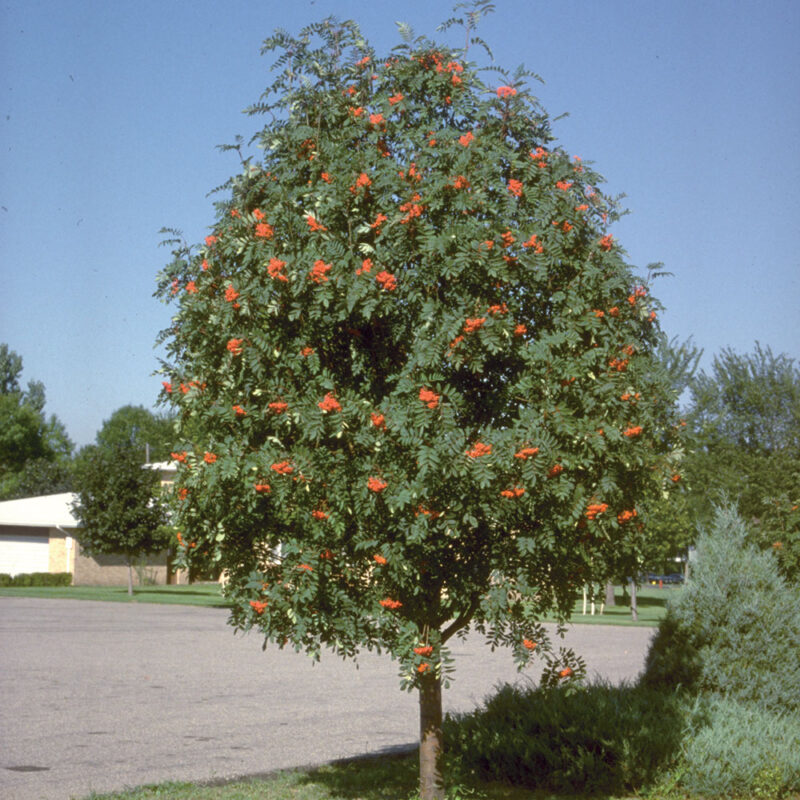1
/
of
1
Riverdene Garden Center
Showy Mountain Ash
Showy Mountain Ash
Regular price
$89.99 CAD
Regular price
Sale price
$89.99 CAD
Unit price
/
per
Couldn't load pickup availability
Sorbus decora
Showy Mountain Ash is a cold-hardy, ornamental tree native to Canada, prized for its clusters of bright red berries, white spring flowers, and stunning fall colour. It thrives in Zone 2-5, making it well-suited for our local climate (Zone 3). Unlike European Mountain Ash, it is more disease-resistant and better adapted to prairie conditions.
Planting & Location
- Hardiness Zone: 2-5
- Mature Size: 20-30 feet tall, 15-20 feet wide
- Growth Rate: Moderate (~12-18 inches per year)
- Sunlight Needs: Full sun to partial shade (at least 6 hours of direct sun preferred)
-
Soil Preference:
- Prefers moist, well-draining loam but tolerates clay and sandy soils.
- Performs best in slightly acidic soil (pH 5.5-6.5) but adapts to neutral soils.
- Avoid overly wet sites—susceptible to root rot in poor drainage.
- Spacing: Plant 15-20 feet apart to allow full canopy development.
Watering
- Young Trees: Water deeply 1-2 times per week during the first 2 years.
- Established Trees: Water every 2-3 weeks in dry periods.
- Drought Tolerance: Moderate but benefits from occasional deep watering in hot summers.
- Winter Watering: If fall is dry, provide one last deep watering before the ground freezes.
Fertilizing
- First Year: No fertilizer needed. Focus on root establishment.
- Mature Trees: Apply a balanced slow-release fertilizer (e.g., 10-10-10) in early spring.
- Organic Alternative: Mulch with compost in spring for gradual nutrient release.
Pruning & Maintenance
- Best Time to Prune: Late winter to early spring (before new growth).
-
How to Prune:
- Remove dead, diseased, or crossing branches to improve airflow.
- Maintain a strong central leader and remove weak growth.
- Avoid heavy summer pruning, as it may stress the tree.
- Suckering: Occasionally produces root suckers—remove them to maintain tree form.
Pest & Disease Management
Common Pests:
-
Mountain Ash Sawfly – Small larvae skeletonize leaves.
- Solution: Handpick larvae, use insecticidal soap if severe.
-
Aphids – Sap-sucking insects that cause leaf curling.
- Solution: Encourage natural predators like ladybugs.
-
Borers – Can attack stressed trees.
- Solution: Keep trees healthy and avoid mechanical injury to bark.
Common Diseases:
-
Fire Blight – Bacterial infection causing blackened, wilted branches.
- Solution: Prune affected branches 8-12 inches below infection and sanitize tools. Avoid excess nitrogen fertilization.
-
Powdery Mildew – White fungal coating on leaves.
- Solution: Improve air circulation, apply fungicide if needed.
-
Rust (Gymnosporangium spp.) – Causes orange spots on leaves and berries.
- Solution: Remove nearby junipers (alternate host), apply fungicide if severe.
Winter Protection
- Young Trees: Wrap the trunk with tree guards or burlap in late fall to prevent sunscald and frost cracks.
- Berries & Wildlife: Birds love the berries in winter, adding seasonal interest. If you prefer to keep the berries longer, consider netting the tree in late summer.
- Mulching: Apply 2-4 inches of mulch around the base (but not touching the trunk) to protect roots from extreme cold.
Landscape Uses
Ornamental shade tree
Wildlife-friendly (berries attract birds)
Low-maintenance and disease-resistant
Beautiful fall colour (orange-red leaves, bright red berries)
Works well in small yards, urban settings, and mixed tree lines
Photo courtesy of Foothills Nursery
Share


